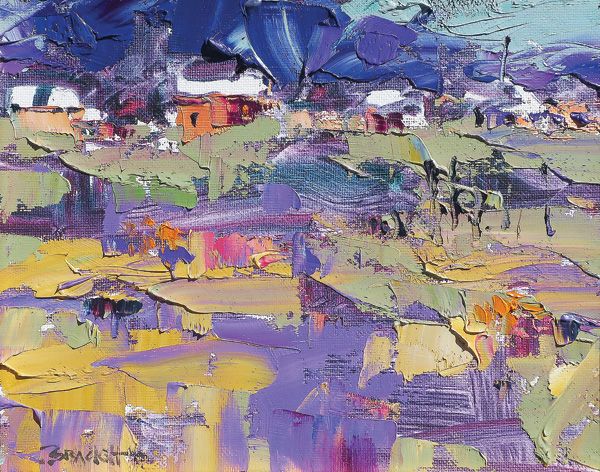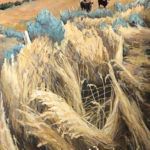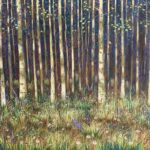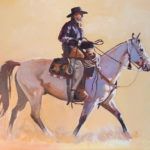Six gallery insiders share sage observations for challenging times
By Norman Kolpas
This story was featured in the October 2020 issue of Southwest Art magazine. Get the Southwest Art October 2020 print issue or digital download now–then subscribe to Southwest Art and never miss another story.
LESS THAN A YEAR AGO, few of us could have imagined that life would soon be turned upside down by a global pandemic. How has this upheaval affected the western art world so far? We sought answers from six established gallery leaders: Ventana Fine Art owner Connie Axton and Manitou Galleries manager Cyndi Hall, both in Santa Fe, NM; Ann Korologos, owner of Ann Korologos Gallery in Basalt, CO; Saks Galleries owner Mikkel Saks in Denver, CO; Beau Alexander, owner of Maxwell Alexander Gallery in Los Angeles, CA; and Jeff Wilcox, manager of Wilcox Gallery in Jackson, WY.
Throughout this challenging period, these experts have kept their businesses going and their staffs employed, caring for the artists they represent and looking after collectors’ needs. Their insights and comments may well enlighten and inspire you.
Closing & Reopening
The most immediate impact of the pandemic on galleries was that last spring, like businesses everywhere, they had to lock their doors for weeks or months, depending on state or local government directives. How galleries have fared since the lockdown ended has depended largely on their location and their preparedness for conducting business online.
- Logan Maxwell Hagege, The Song at Sunset, oil, 96 x 144, Maxwell Alexander Gallery.
- Sushe Felix, Don’t Stop Believin’, acrylic, 36 x 72, Manitou Galleries.
- Heather Foster, Tall Grass, acrylic, 48 x 30, Ann Korologos Gallery.
In a town whose economy relies so much on tourism and is known for its almost 300 art galleries, Santa Fe has felt the downturn seriously. A state-mandated 14-day quarantine for anyone arriving from outside New Mexico’s borders, as well as the cancellation of the annual Indian Market in mid-August, made the city’s streets as devoid of visitors in the summer as they usually are during winter’s slow season. Now, notes Connie Axton of Ventana, “there are empty spaces” where some galleries used to be. Jackson, WY, another gallery-rich location that thrives on tourism, felt a similar impact: “The first two and a half months were a bummer,” says Jeff Wilcox. But then, he adds, “in summer we went from a trickle to a roar.” Uncertainty, of course, still lingers, fueled by the latest case numbers reported in the media. Says Cyndi Hall of Manitou, “You’ll have 10 really great days and then you’ll think, ‘Oh my goodness, are we going to get shut down again?’”
Galleries elsewhere have had their own government-required shutdowns and their own local rebounds. “We were closed for two months,” says Mikkel Saks of Saks Galleries in Denver’s upscale Cherry Creek neighborhood. “But Denver is a boomtown right now. Ever since we reopened our doors in late May, business has been fabulous.” In the small Rocky Mountain town of Basalt, Ann Korologos Gallery has also been doing exception-ally well since the state allowed the doors to reopen. “Our sales now are way up from recent years,” says Korologos.
- Olga and Aleksey Ivanov, Aspen Grove Summer, egg tempera, 16 x 20, Saks Galleries.
- Brett Allen Johnson, The Little Colorado, oil, 38 x 38, Maxwell Alexander Gallery.
- Barry McCuan, Bonjour, oil, 24 x 30, Ventana Fine Art.
The same holds true for Maxwell Alexander Gallery in downtown Los Angeles, which was among the “nonessential” businesses the city ordered to close their doors in mid-March. “Yet, in April 2020, we literally doubled our sales over April 2019, and that wasn’t a bad month last year,” says Beau Alexander. The following month, their solo show for gallery superstar Logan Maxwell Hagege was “the highest-grossing show we’ve ever had, period, right in the thick of the pandemic shutdown. It’s bizarre, especially when I know that so many people out there are struggling.” What makes those results even more remarkable, says Alexander, is that he has kept his gallery doors closed, opening them only by appointment—with collectors appropriately masked, hand-sanitized, and socially distanced, of course, as all six galleries now require of visitors while the pandemic persists.
Brave New Digital World
Each expert we spoke with credits the online world for enabling them to persevere through the current vicissitudes. Korologos and her team built a virtual presence for the gallery back in 2010, three years after she bought it, as a strategic way to support the business. “We may be a midsize gallery in a small town,” she says, “but thanks to digital, we have a big footprint with a reach that is national and international.” Alexander, too, felt well equipped to deal with the challenges. “I’m already used to operating my business via social media, email, and phone, so I immediately fell back on that. A lot of our collectors are in places like Texas, Montana, and Colorado and are already used to doing business that way.”
- Giuseppe Palumbo, One More Time, bronze, 43 x 38 x 21, Ventana Fine Art.
- Jim Wilcox, Mountain Garden, oil, 40 x 60, Wilcox Gallery.
- Peggy Judy, Heading Out, oil, 24 x 28, Ann Korologos Gallery.
All of the galleries have become even more creative in their online activities since the spring shutdown. “We said the trick was to be innovative and ahead of the curve,” says Cyndi Hall at Manitou. In her case, that meant not only exploring new media but also knowing when to scale it back. “We were one of the first galleries around to figure out Zoom openings,” she says. “But as people have been getting back into the workforce and having to videoconference, they got Zoom fatigue. So we slowed that down and tried to find other ways to fit into collectors’ lives without being disruptive.”
One effective solution Hall and others found has been to create videos to post online and on social media. “We’ve had all our artists make their own two- or three-minute videos, showing us what their studios look like or special techniques they’ve developed,” she says. Hall mentions a brief video that artist Sushe Felix shot in mid-August demonstrating how she makes her ethereal acrylic paintings. “In its first three days on social media, it had more than 1,200 views and so many comments,” Hall says.
Similarly, Beau Alexander produces a five- to 10-minute video walk-through of each new exhibition—including one for a show this month on contemporary landscapist Brett Allen Johnson—that aims to capture a visitor’s point of view, “stopping in front of each artwork and then stepping in closer to look at it in detail.” He also provides images of the paintings in frames, the better to help buyers imagine them hanging in their homes.
- Margaret Nes, Blue Walls, White Roofs, pastel, 20 x 28, Ventana Fine Art.
- Kyle Ma, Afternoon at String Lake, oil, 20 x 24, Wilcox Gallery.
- Kathleen Frank, Oaxaca, oil, 30 x 40, Saks Galleries.
Connie Axton and her gallery staff have been streaming live interviews with artists during virtual opening nights for new shows. But they also asked themselves, “What can we do to promote our other, equally important artists who aren’t having one-person shows this year?” That led them to film two informative, professionally produced videos for their website and social media: one looks at painters Doug Dawson, Dick Evans, Barry McCuan, Margaret Nes, Mary Silverwood, and John Nieto; the other features sculptors Mark Yale Harris, Cassidy Watt, Jim Agius, Giuseppe Palumbo, Jimmy Cook, Roger Martin, and Brittany Weaver.
Mikkel Saks, while swearing off in-person openings until early next year, has worked with his staff to create online themes promoted through social media. This month’s is realism, featuring works by artists Anna Rose Bain, Olga and Aleksey Ivanov, Andrea Kemp, and Jane Jones. “They use the techniques of the old masters,” observes Saks, “to express the sentiments of modern society.” Cyndi Hall and her colleagues at Manitou, meanwhile, have been thinking about new show themes “that explore truly impactful ideas. In times like these, we have that responsibility,” she says. To that end, they’re considering one show on New Mexico buildings that have had particular impacts on art, and another on “how you ex-press the idea of family, friends, and loved ones through art that isn’t figurative.”
In short, all of the galleries are bringing considerable imagination into play to breathe new excitement into the gallery experience at a time when many people can’t or won’t actually visit. Says Axton, “We’re making sales, but we’re working twice as hard as we ever have.”
Art Lovers Respond
Without exception, each gallery representative marvels at the enthusiasm shown by longstanding and new collectors alike for purchasing art during the pandemic. Ann Korologos eloquently sums up the reason with a favorite quote from legendary dancer and choreographer Twyla Tharp: “Art is the only way to run away without leaving home.”
- Logan Maxwell Hagege, The Man From Bylas, oil, 32 x 25, Maxwell Alexander Gallery.
- Tim Shinabarger, The Apparition, bronze, 40 x 22 x 13, Wilcox Gallery.
- Andrea Kemp, Space to Roam, oil, 24 x 36, Saks Galleries.
At a time when fewer people want to leave the shelter of home, art offers a sense of escape through the appreciation of human creativity and the world’s beauty. Notes Mikkel Saks, “People can’t travel, they’re not spending money on vacations, and they can’t eat out. They’re looking at their walls and thinking, ‘Maybe we should get something nice to look at.’” Jeff Wilcox says that many of his customers have been snapping up works by his father, impressionist painter and gallery founder Jim Wilcox, as well as bronzes by respected sculptors like Sandy Scott, Tim Shinabarger, and J. Christopher White—clear signs that work by well-established artists, and art that is literally substantial, holds appeal. Connie Axton adds, “Art is something people can control. If they find the piece that moves them”—whether online or in person—“they can even send us a picture of their room and we’ll Photoshop the painting on their wall,” so they can see how it will look. Most of the other galleries provide buyers with that same service.
Nor are longtime buyers the only ones venturing into the art market. “We were really shocked that people who had never collected before were buying,” says Cyndi Hall. “They were looking for some sort of distraction that made them happy. And a lot of people expressed that they were also really fearful for the livelihoods of the artists.”
Speaking of how artists have been faring: Most of the gallerists report that their artists are doing well—concerned about staying safe, of course, but still industriously at work in their studios. Says Beau Alexander, “Initially, across the board, everyone was unsure and a little worried. A lot of the artists were checking in with me, asking me what the temperature of the market was and feeling apprehensive about the future. I let them know that things are going well and people are buying.” Now, however, he says the artists he represents seem to feel more at ease. “After all,” he adds with a chuckle, “look at an artist’s lifestyle. It’s really not much different from quarantine.”
- Don Brackett, The Good Earth, oil, 8 x 10, Manitou Galleries.
- Kate Starling, Four O’Clock, oil, 60 x 40, Ann Korologos Gallery.
- Jim Wilcox, Evening Serenade, oil, 24 x 18, Wilcox Gallery.
Indeed, sheltering at home may even produce some positive effects for artists. During the shutdown, observes Mikkel Saks, “I think maybe they’re working a little bit harder, exploring new territory.” Cyndi Hall has seen the same phenomenon, citing New Mexico painter B.C. Nowlin as an example. “He’s doing suites of paintings that are completely brand new yet absolutely recognizable as his work,” she says. “And they’re selling.”
Human Kindness
As is often the case in the midst of shared adversity, there have been some remarkable expressions of the human spirit. Consider, for example, an artistic take on the coloring book, whose popularity has surged during the pandemic: Manitou Galleries invited its artists to contribute black-and-white line art based on their paintings for a 30-page digital coloring book, which they distributed free to clients. It featured a wide variety of images from gallery regulars including Nocona Burgess, Sharon Markwardt, and Kim Wiggins. “Our artists really are like family,” says Cyndi Hall.
In a moving example of art’s healing power, Connie Axton describes a recent sale: “A long-standing customer saw some of John Axton’s paintings on our website and sent me an email that he was interested in buying a particular one if it was still available. I called him. He was in the hospital recovering from Covid and was going home at the end of the week. And that art meant something to him. ‘I don’t know where I’m going to put it,’ he told me, ‘but I’m going to find room.’”
- Brett Allen Johnson, Black Magic, oil, 28 x 28, Maxwell Alexander Gallery.
- Roger Martin, Patience, bronze, 24 x 18 x 17, Ventana Fine Art.
- Kathleen Frank, Path to the Tetons, oil, 60 x 48, Saks Galleries.
Often, the love comes right back to the galleries from their artists and clients. Many of Manitou’s clients have taken to stopping by its two locations, which are open but relatively quiet with so few tourists in Santa Fe. “They bring us desserts, or produce from their gardens,” says Hall. “One even handmade us a bunch of masks with peace signs, to cheer us up.”
Don Brackett, a longtime Manitou artist who lives in Taos, recently stopped by the gallery unannounced, carrying an armload of 14 small, framed paintings he’d done. “He lined them up along the wall and told us that there was one painting for each of us who worked in the gallery, and we should take our pick,” Hall recalls. “On the back of each one, he had written, ‘Thank you for all of your hard work during this pandemic.’”
We all would do well to repeat such words of gratitude to everyone—artists, gallerists, collectors, and more—who is working so hard right now to keep the state of the western art market strong.
- Deborah Paris, Hillside Aspens, oil, 36 x 24, Ann Korologos Gallery.
- Sushe Felix, Blossom Battle, acrylic, 12 x 12, Manitou Galleries.
- Doug Dawson, First Sign of Fall, pastel, 15 x 18, Ventana Fine Art.
This story was featured in the October 2020 issue of Southwest Art magazine. Get the Southwest Art October 2020 print issue or digital download now–then subscribe to Southwest Art and never miss another story.
MORE RESOURCES FOR ART COLLECTORS & ENTHUSIASTS
• Subscribe to Southwest Art magazine
• Learn how to paint & how to draw with downloads, videos & more
• Sign up for your Southwest Art email newsletter & download a FREE ebook






























